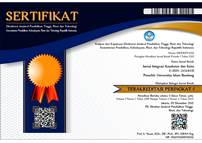Uji Daya Proteksi Losion Minyak Atsiri Daun Mint (Mentha x piperita L.) sebagai Repelan terhadap Nyamuk Aedes aegypti
Abstract
Abstrak
Gigitan nyamuk merupakan masalah kesehatan umum yang dihadapi banyak orang di seluruh dunia. Selain mengakibatkan ketidaknyamanan dan rasa gatal, gigitan nyamuk juga dapat menyebabkan penularan penyakit seperti DBD dan malaria. Repelan merupakan zat kimia yang mampu mengusir serangga dari manusia. Senyawa kimia yang sering digunakan untuk repelan adalah N,N-Dietil-m-toluamida (DEET). Tujuan penelitian ini adalah mengidentifikasi kandungan senyawa dalam minyak atsiri daun mint, menganalisis karakteristik fisik losion minyak atsiri daun mint, dan menguji daya proteksi sediaan losion daun mint sebagai repelan terhadap nyamuk Aedes aegypti. Metode yang digunakan adalah experimental research. Penelitian ini dilakukan di Laboratorium Farmasi Universitas Singaperbangsa Karawang, Laboratorium Kimia Instrumen Universitas Pendidikan Indonesia, dan Litbangkes Pangandaran selama bulan Desember 2023 sampai April 2024. Subjek penelitian ini menggunakan nyamuk Aedes aegypti dan analisis data yang dilakukan menggunakan microsoft excel. Hasil penelitian ini menunjukkan pada analisis dengan GC-MS komponen terbesar dalam minyak atsiri daun mint (Mentha x piperita L.) adalah carvone, α-ocimene, Limonene, α-terpinolene, dan γ-terpinene. Karakteristik fisik pada losion minyak atsiri daun mint memenuhi syarat berdasar evaluasi yang telah dilakukan. Pada pengujian daya proteksi menunjukkan bahwa pada jam ke-0 losion minyak atsiri daun mint dengan konsentrasi minyak atsiri daun mint 5% daya proteksi tertinggi sebesar 93,72%; konsentrasi minyak atsiri daun mint 10% daya proteksi tertinggi sebesar 94,50%; dan pada konsentrasi minyak atsiri daun mint 15% daya proteksi tertinggi sebesar 97,05%. Daya proteksi dari konsentrasi masing-masing mengalami penurunan pada jam ke-1 sampai dengan jam ke-5. Simpulan, sediaan losion minyak atsiri daun mint konsentrasi 15% merupakan daya proteksi paling tinggi, namun kurang efektif untuk digunakan sebagai repelan.
Protective Efficacy Test of Mint Essential Oil Lotion (Mentha x piperita L.) as a Repellent Against Aedes aegypti Mosquitoes
Abstract
Mosquito bites are a common health problem many people worldwide face. In addition to causing discomfort and itching, mosquito bites can also cause the transmission of diseases such as dengue and malaria. Repelling is a chemical substance that can repel insects from humans. A chemical compound often used for repelling is N, N-Dietyl-m-toluamide (DEET). The purpose of this study is to identify the content of compounds in mint leaf essential oil, analyze the physical characteristics of mint leaf essential oil lotion, and test the protective power of mint leaf lotion preparations as a repellent against Aedes aegypti mosquitoes. The method used is experimental research. During five months, this research was conducted in the Pharmacy Laboratory of Singaperbangsa University Karawang, the Instrument Chemistry Laboratory of the Indonesian Education University, and Pangandaran Health Research and Development during December 2023 until April 2024. The subject of this study used the Aedes aegypti mosquito, and data analysis was carried out using Microsoft Excel. This study showed that the most significant components in mint leaf essential oil (Mentha x piperita L.) were carvone, α-ocimene, limonene, α-terpinolene, and γ-terpinene. The physical characteristics of the mint leaf essential oil lotion meet the requirements of the evaluation that has been carried out. The protection test showed that at the 0th hour of mint leaf essential oil lotion with a mint leaf essential oil concentration of 5%, the highest protection power was 93.72%, the concentration of mint leaf essential oil was 10%, the highest protection power was 94.50%, and at the concentration of mint leaf essential oil of 15%, the highest protection power was 97.05%. The protection of each concentration decreased from the 1st to the 5th hour. In conclusion, mint leaf essential oil lotion preparations, with a concentration of 15%, are the highest protection but less effective for use as a repellent.
Keywords
Full Text:
PDF (Bahasa Indonesia)References
Farasari R, Azinar M. Model buku saku dan rapor pemantauan jentik dalam meningkatkan per-ilaku pemberantasan sarang nyamuk. J Health Educat. 2019;3(2):110–7.
World Health Organisation. Dengue and severe dengue. Geneva: WHO Fact Sheet; 2020.
Suharyo S, Widjanarko B. Pengendalian vektor nyamuk demam berdarah melalui rekayasa ge-netika serta perspektif bioetika. Bookchapter Kesehatan Masyarakat Universitas Negeri Sema-rang. 2023;(3):25–46.
Wardani S. Ekstraksi daun kemangi (Ocimum basilicum L.) dan daun jeruk purut (Citrus hystrix) sebagai bahan baku pembuatan losion anti nyamuk [Doctoral Dissertation]. Makassar: Politeknik Negeri Ujung Pandang; 2022.
Hestiana A, Yasin N, Hariri AM, Subeki S. Aktivitas antifidan ekstrak daun mint (Mentha arven-sis L.) dan buah lada hitam (Piper nigrum L.) terhadap ulat krop kubis (Crocidolompa pavonana F.). J Agrotek Tropika. 2014;2(1):124–8.
Amalia T, Sukmawati. Formulasi dan evaluasi sediaan lotion ekstrak buah ketumbar (Cori-andrum sativum L.) sebagai anti nyamuk Aedes albopictus. Parapemikir: J Ilm Farmasi. 2022;11(1):66–74.
Yanti, NLMYI, Arpiwi NL, Yulihastuti DA. Minyak atsiri daun kemangi (Ocimum x africanum Lour.) dan efektivitasnya sebagai lotion antinyamuk terhadap Aedes aegypti (Linneaeus, 1762). J Metamorfosa: J Biological Sci. 2020;7(2):248–58.
Departemen Pertanian RI. Metode standar pengujian efikasi pestisida. Jakarta: Komisi Pestis-ida Departemen Pertanian RI; 1995.
Arsita M, Lestari U, Elisma E, Efendi MR. Physical properties and anti-mosquito activities of lo-tion male from palm flower extract (Elaeis guineensis Jacq.). IJPST. 2022;1(1):41–9.
Theochari I, Giatropoulos A, Papadimitriou V, Karras V, Balatsos G, Papachristos D, dkk. Physi-cochemical characteristics of four limonene-based nanoemulsions and their larvicidal proper-ties against two mosquito species, aedes albopictus and culex pipiens molestus. Insects. 2020;11(11):740.
Ayu, Gusti Primandari Utami, Sri Rahayu Santi, Ni Made Puspitawati. Minyak atsiri daun tenggulun (Protium javanicum Burm.F.) sebagai repellent nyamuk demam berdarah (Aedes ae-gypti). J Kimia. 2014;8(1):70–6.
DOI: https://doi.org/10.29313/jiks.v6i2.13726
Refbacks
- There are currently no refbacks.
Jurnal Integrasi Kesehatan dan Sains is licensed under a Creative Commons Attribution-NonCommercial-ShareAlike 4.0 International License.







.png)
_(1).png)




















